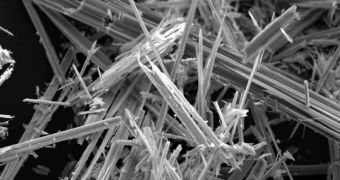A new study published yesterday implies that carbon nanotubes may behave like asbestos when being inhaled in particular quantities. Similar to asbestos, carbon nanotubes may triggers a form of lung cancer known as mesothelioma, which appears within three to four decades after the exposure. Simply put, the study says that carbon nanotubes looking like asbestos usually behave like it as well.
Carbon nanotubes were discovered some two decades ago, and are believed to be one of the most important factors in the so-called nanotechnology revolution. Their unique properties are currently being used to create new means to deliver drugs, or to create ultra-efficient power sources and nanoscale electronics. Today, more than two billion US dollars are spent annually for carbon nanotubes research, including single and multi-walled carbon nanotubes.
"This study is exactly the kind of strategic, highly focused research needed to ensure the safe and responsible development of nanotechnology. It looks at a specific nanoscale material expected to have widespread commercial applications and asks specific questions about a specific health hazard. Even though scientists have been raising concerns about the safety of long, thin carbon nanotubes for over a decade, none of the research needs in the current U.S. federal nanotechnology environment, health and safety risk research strategy address this question", says co-author of the study Andrew Maynard, Chief Science Advisor to the Project on Emerging Nanotechnologies.
Asbestos is a naturally occurring mineral that crystallizes in long, thin fibers. It became widely used during the 19th century, having exceptional heat, electrical and chemical resistant properties. Since it was established that it causes cancer in people exposed to it, it was banned in most countries. Today it is only used in brake shoes and gaskets as well as electrical insulation and as flame-retardant in a range of applications.
In the US, asbestos exposure has been declared the most hazardous occupation in history and the cost related to diseases triggered by it is expected to exceed 200 billion US dollars.
"The toll of asbestos-related cancer, first noticed in the 1950s and 1960s, is likely to continue for several more decades even though usage reduced rapidly some 25 years ago. While there are reasons to suppose that nanotubes can be used safely, this will depend on appropriate steps being taken to prevent them from being inhaled in the places they are manufactured, used and ultimately disposed of. Such steps should be based on research into exposure and risk prevention, leading to regulation of their use. Following this study, the results of which were foreseen by the Royal Society in the U.K. in 2004, we can no longer delay investing in such research", said Anthony Seaton professor emeritus at the University of Aberdeen.
The research was led by professor Kenneth Donaldson from the University of Edinburgh who examined the effects of long and short carbon nanotube exposure by injecting a sample into mice. "The results were clear. Long, thin carbon nanotubes showed the same effects as long, thin asbestos fibers", said Donaldson.
Long, thin asbestos fibers are able to insert themselves deep inside the lung, preventing it from performing normal functions just like any other clearly harmful particles.
"We still don't know whether carbon nanotubes will become airborne and be inhaled, or whether, if they do reach the lungs, they can work their way to the sensitive outer lining. But if they do get there in sufficient quantity, there is a chance that some people will develop cancer - perhaps decades after breathing the stuff", Donaldson said.
Although curly carbon nanotubes do not seem to behave as asbestos does during interaction with the tissue of the lung, long thin ones may present a problem. The good news is that carbon nanotubes are much easier to control. Additionally, carbon nanotubes have not been proven to cause any other damage to the lungs but much more research is needed before a final word can be said regarding this issue.

 14 DAY TRIAL //
14 DAY TRIAL //